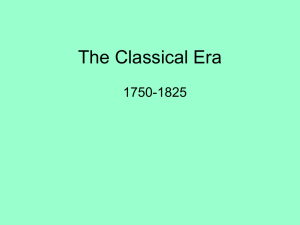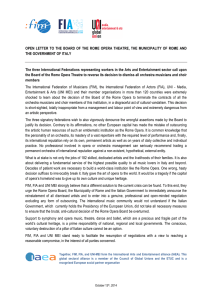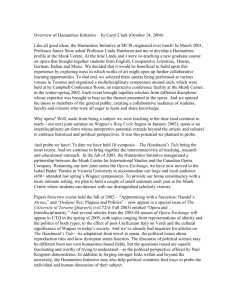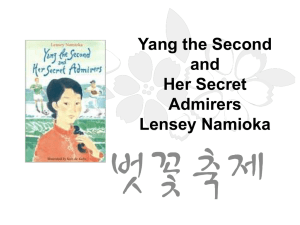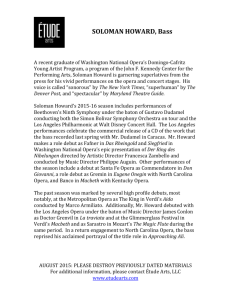AREA TITLE/DESCRIPTION INSTRUCTOR/AFFILIATION
advertisement
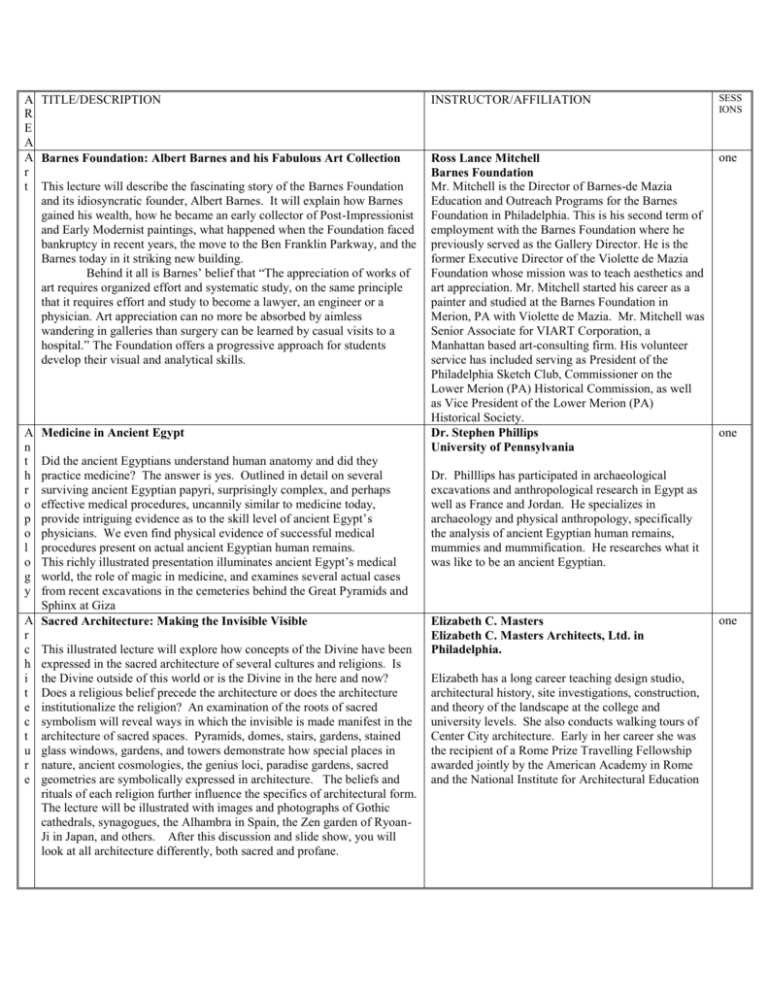
A TITLE/DESCRIPTION R E A A Barnes Foundation: Albert Barnes and his Fabulous Art Collection r t This lecture will describe the fascinating story of the Barnes Foundation and its idiosyncratic founder, Albert Barnes. It will explain how Barnes gained his wealth, how he became an early collector of Post-Impressionist and Early Modernist paintings, what happened when the Foundation faced bankruptcy in recent years, the move to the Ben Franklin Parkway, and the Barnes today in it striking new building. Behind it all is Barnes’ belief that “The appreciation of works of art requires organized effort and systematic study, on the same principle that it requires effort and study to become a lawyer, an engineer or a physician. Art appreciation can no more be absorbed by aimless wandering in galleries than surgery can be learned by casual visits to a hospital.” The Foundation offers a progressive approach for students develop their visual and analytical skills. A n t h r o p o l o g y Medicine in Ancient Egypt Did the ancient Egyptians understand human anatomy and did they practice medicine? The answer is yes. Outlined in detail on several surviving ancient Egyptian papyri, surprisingly complex, and perhaps effective medical procedures, uncannily similar to medicine today, provide intriguing evidence as to the skill level of ancient Egypt’s physicians. We even find physical evidence of successful medical procedures present on actual ancient Egyptian human remains. This richly illustrated presentation illuminates ancient Egypt’s medical world, the role of magic in medicine, and examines several actual cases from recent excavations in the cemeteries behind the Great Pyramids and Sphinx at Giza A Sacred Architecture: Making the Invisible Visible r c This illustrated lecture will explore how concepts of the Divine have been h expressed in the sacred architecture of several cultures and religions. Is i the Divine outside of this world or is the Divine in the here and now? t Does a religious belief precede the architecture or does the architecture e institutionalize the religion? An examination of the roots of sacred c symbolism will reveal ways in which the invisible is made manifest in the t architecture of sacred spaces. Pyramids, domes, stairs, gardens, stained u glass windows, gardens, and towers demonstrate how special places in r nature, ancient cosmologies, the genius loci, paradise gardens, sacred e geometries are symbolically expressed in architecture. The beliefs and rituals of each religion further influence the specifics of architectural form. The lecture will be illustrated with images and photographs of Gothic cathedrals, synagogues, the Alhambra in Spain, the Zen garden of RyoanJi in Japan, and others. After this discussion and slide show, you will look at all architecture differently, both sacred and profane. INSTRUCTOR/AFFILIATION SESS IONS Ross Lance Mitchell Barnes Foundation Mr. Mitchell is the Director of Barnes-de Mazia Education and Outreach Programs for the Barnes Foundation in Philadelphia. This is his second term of employment with the Barnes Foundation where he previously served as the Gallery Director. He is the former Executive Director of the Violette de Mazia Foundation whose mission was to teach aesthetics and art appreciation. Mr. Mitchell started his career as a painter and studied at the Barnes Foundation in Merion, PA with Violette de Mazia. Mr. Mitchell was Senior Associate for VIART Corporation, a Manhattan based art-consulting firm. His volunteer service has included serving as President of the Philadelphia Sketch Club, Commissioner on the Lower Merion (PA) Historical Commission, as well as Vice President of the Lower Merion (PA) Historical Society. Dr. Stephen Phillips University of Pennsylvania one one Dr. Philllips has participated in archaeological excavations and anthropological research in Egypt as well as France and Jordan. He specializes in archaeology and physical anthropology, specifically the analysis of ancient Egyptian human remains, mummies and mummification. He researches what it was like to be an ancient Egyptian. Elizabeth C. Masters Elizabeth C. Masters Architects, Ltd. in Philadelphia. Elizabeth has a long career teaching design studio, architectural history, site investigations, construction, and theory of the landscape at the college and university levels. She also conducts walking tours of Center City architecture. Early in her career she was the recipient of a Rome Prize Travelling Fellowship awarded jointly by the American Academy in Rome and the National Institute for Architectural Education one h i s t o r y The Adams Women H i s t o r y James Arthur Garfield, 20th U.S. President: The Effect of his Assassination and Secret Illnesses on World History and Politics An examination of the life, achievements and failures of a littleremembered United States President. At the 1880 Republican National Convention, Garfield was a compromise candidate chosen on the 30th ballot. His election to the presidency was the closest in U.S. history, closer even than Kennedy vs. Nixon. Though Garfield had served as a general in the Union Army, and survived nine terms in Congress representing Ohio, it was an assign’s bullet that struck him after only four months in the White House. For the next 100 days, doctors fumbled with his wound until his death. How did he function as President after being shot? Could he have been saved? How did his death change American political history? Dr. Schwartz has had an impressive and distinguished career in the medical profession and has won numerous awards and distinctions throughout his career. With over 30 years of clinical practice experience in nephrology and hypertension, he has worked at several area hospitals. He currently teaches the subjects of nephrology and hypertension and gives medical education presentations for physicians and other medical practitioners. His lecture is based on his long standing clinical observations and research in U.S. presidential history. Dr. Schwartz has given his lecture series throughout the U.S. His Presidential Lecture Series includes; Roosevelt, Kennedy, Nixon and more. H i s t o r y Native America: Dr. Juilene Osborne-McKnight DeSales University Most modern Americans don't realize that before the Europeans landed in America, there were more than five hundred different nations of American Indian peoples, speaking at least two hundred distinct languages. Our lecture will look at the vast nature of precolonial Native America, from tribes living in the great forest cathedrals of the East, to the bareback horseman of the plains, the whale hunters of the Northwest and the pueblo dwellers of the southwest. We will look at customs, beliefs, myths and practices of these nations and will touch on their continuing presence in the United States today. Dr. McKnight is the founder of the DiScoUrse Creative Writing Honor Society. In the fall of 2014, DeSales named her Visiting Professor Abroad, during which time she lived and taught in Rome, Italy. She has also directed several trips to Ireland with her students at DeSales. Professor Osborne-McKnight speaks Irish Gaelic and is a traditional senachai (storyteller) in the ancient Irish tradition. In 2014 she was named Creative Writing Laureate by Carlow University in Pittsburgh While John Adams, John Quincy Adams, Charles Francis Adams, and Henry Adams are remembered for their impact on American history, historians have failed to recognize adequately the roles played by the Adams women - - Abigail, Louisa, and others. This course will address the history of the Adams women from the eighteenth to twentieth century. The first session will be centered on Abigail and Louisa Adams and the second on the wives of Charles Francis Adams and Henry Adams. Timeline and bibliography will be distributed. Dr. William Walker Professor Emeritus, Chestnut Hill College In 2008 Dr. Walker retired from Chestnut Hill College as the Senior Vice President, Vice President for Academic Affairs and Dean of the Faculty. He previously served as an administrator and a member of the history faculties at the University of the Sciences, Gwynedd-Mercy College, the University of South Carolina at Sumter, Clemson University at Sumter and Villanova University. Dr. Walker continues to be affiliated with Chestnut Hill College as an adjunct Professor of History and conducts research and writing. He is the author of McCarthyism and The Red Scare; Term Paper Resource Guide on Nineteenth Century World History; Essentials of European History 18481914: Realism and Materialism and America and the Cold War. He is researching Zurich 1914-18 and America During the Pre-War Years, 1939-41. He has co-written three additional books, edited two books and published numerous articles and book reviews on history. Dr. Allan B. Schwartz Drexel University two one one H i s t o r y 1939-1945: The Music of World War 2 H i s t o r y Singapore: An Asian Tiger H i s t o r y The Lincoln’s H i s t o Music’s Greatest Legends WW 2 "was a glorious time for songs." Families depended on their radio for home entertainment. During the war, radios were filled with new patriotic and sentimental songs; romantic ballads and many novelty songs reached the top of the music charts. This was the era of the big band and many young vocalists became stars. Learn about the music that got us through the war. Most people know Singapore is one of the “Asian tigers” that went from Third World to economic powerhouse in a couple of decades. But what else do you know? You might be surprised to learn that Singapore is not in China, chewing gum is not illegal and it’s not a dictatorship. (Law breakers may still get caned however.) This lecture will trace the history and development of Singapore from its early days as an outpost of the British East India Company to its development as an economic powerhouse in Southeast Asia. You will also learn how this tiny island became a nation of immigrants and, eventually, a colorful, multi-ethnic society. This is a story of Abraham Lincoln’s family. From its beginning in America to the last of the line that ended 1985. It is not just a look at Abe and Mary but their children and their grandchildren, their successes, failures, their illnesses and their many tragedies. This is an important look at an American family with the 16th President at its head and how they impacted our history. Music, we are compelled by it. We are provoked by it. We are moved by it. We are inspired by it. We feel connected to it. Music reflects something profound about who we are and our experience in the world. Herb Kaufman Association of American Presenters Mr. Kaufman has received numerous awards including the Award of Merit from the Delaware Valley Civil War Round Table and the Samuel Towne Award from the Grand Army of the Republic Museum. He has also received several awards for his continuing work in education and support of the history of the Civil War. Mr. Kaufman has been a Civil War re-enactor and has created many programs for students and adults at the Civil War Museum of Philadelphia Dr. Susan Adler, Professor Emerita at the University of MissouriKansas City (UMKC) Dr. Adler was the Director of Teacher Education UMK . She was a Visiting Professor at the National Institute for Education (2009-2011) and previously served as Senior Visiting Fellow at NIE in 2004. Early in her career she taught middle school social studies in the U.S. She has published numerous articles on social studies teacher education, edited a volume entitled Critical Issues in Social Studies Teacher Education, and co-authored Cultural Foundations of Education. She is a past president of the National Council of the Social Studies and has worked extensively with pre-service and in-service teachers, both on-campus and in school based workshops Hug Boyle Mr. Boyle is the president of the Grand Army of the Republic Museum in Philadelphia. He is a retired sales executive from Roadpro Electronics. He is also the former publisher of the newspaper “Civil War Brigadier.” Mr. Boyle has taught sales and marketing courses at Holy Family College and Manor College. He is the founder and president of the April 1865 Society, president and founding member of the Delaware Valley Civil War Roundtable and a lecturer for the Association of American History Presenters. As a historian he devotes his research to 19th century presidential politics with a special emphasis on the historical events of that century. He has lectured at high schools, historical societies, seminars and symposiums and has been filmed for public broadcasting Jerry Millevoi Jerry Millevoi Photography, Doylestown Adjunct Instructor Bucks County Community College one one one one r y / F i l m An upbeat piece of music can lift our spirits. Given the emotionally charged nature of music, it can be an effective method for expressing ourselves and assisting us in coping with challenging circumstances. In this program, we’ll watch clips from films portraying some of the most creative and talented musicians in the world. L i t e r a t u r e Chaucer’s Women, Part Two: Virtuous, Heroic Women of The Canterbury Tales Among the many colorful women who inhabit Chaucer’s masterpiece, some are naughty, such as the lusty Wife of Bath, the coltish Alisoun of the “Miller’s Tale,” and the high-maintenance wife of the “Shipman’s Tale.” But just as many are virtuous and respectable, including several faithful and patient wives, devoted mothers, holy virgins and martyrs, and obedient daughters. This presentation will focus on the latter, exploring how the so-called Father of English Poetry, often borrowing his stories from earlier sources, creates women whose actions contradict the standard anti-feminist stereotypes of much medieval literature and provide enjoyment, instruction, and inspiration to his many readers. L Thornton Wilder, Our Town, and the Puritan Narrative Tradition i t This course will share many of the points about the Pulitzer Prize-winning e play Our Town from my monograph Thornton Wilder and the Puritan r Narrative Tradition. One particular legacy of the Puritans, the American a jeremiad, extends from the sermons of 17th-century New England t ministers, to the speeches and publications of the Revolutionary War, u through classic American literature, and even to the social commentary of r 20th-century writers and politicians. The American jeremiad was no mere e fire-and-brimstone sermon; rather it was a national ritual of progress manifested during times of cultural crisis. As the Great Depression lingered and Europe was headed toward another war, Wilder wrote Our Town as a dramatic expression of the ultimately affirmative rhetoric of the New England Puritans. L i t e r a t Post-colonialism and Asian American Literature In 1976, Maxine Hong Kingston made a remarkable debut with The Woman Warrior, which soon became a global classic. Amy Tan followed suit with Joy Luck Club, which remained a national bestseller for nearly a year. Since then, talented American writers of Asian descent—Gish Jen, Chang-rae Lee, and Ruth Ozeki, to name only a few—have produced excellent literary works. As an adjunct instructor at Bucks County Community College, he developed the course material for a class entitled Interpreting History through Cinema. This course investigates motion pictures as historical texts and examines how cinema creates a window for viewing American culture, politics and society. Students analyze and evaluate motion pictures and learn to recognize the uniqueness of film as an alternate method for exploring, dissecting and comprehending history. He also teaches U.S. History I and The American Indian. As a lecturer, Mr. Millevoi has delivered over 50 cinema/history presentations to retirement communities, historical associations and libraries. This widely accepted lecture series, also entitled Interpreting History through Cinema, provides an introspective and fascinating view of cinema from a historical perspective Dr. Carol Breslin Professor emerita of English, Gwynedd Mercy University one Dr. Breslin earned her doctorate in literature from Temple University with a specialty in Chaucer's Canterbury Tales. Current research and teaching interests include women writers of the Middle Ages, the life and legacy of Nobel laureate Pearl S. Buck, strategies for effective teaching of grammar and writing, as well as continued exploration of the works of Chaucer. Dr. Lincoln Konkle Professor of English at The College of New Jersey Professor of English at The College of New Jersey where he teaches courses primarily in dramatic literature. He teaches the First Seminar, World Drama, Modern European Drama, American Drama, and the English Major capstone course, Seminar in Theory and Research, on topics related to dramatic literature. Besides Thornton Wilder, he has published and presented on works by Edward Albee, Tennessee Williams, Bruce Springsteen, and others. He co-edited Stephen Vincent Benet: Essays on His Life and Work, and Thornton Wilder: New Perspectives. He has served as Executive Director of the Thornton Wilder Society since 2005 and is an officer of the Edward Albee Society. Dr. Seiwoong Oh Professor and Chair, English, Rider University Dr. Oh specializes in British Renaissance literature including Shakespeare and Milton. He has also been interested in Asian American literature and has written extensively on cross-cultural reading in multicultural literature. At Rider he teaches: Seminar one one u r To enrich our understanding of the works by these authors, we will review e the cultural history of Asian Americans and borrow some of the key terms and ideas of “postcolonial studies” to analyze the thematic concerns of Asian American literature. L Facing Shakespeare i William Shakespeare’s face is so familiar that few who will be attending t this lecture would fail to recognize him if he suddenly walked in the room. e Yet does anyone know what Shakespeare really looked like? In pursuit of r that question, June Schlueter, Professor of English Emerita at Lafayette a College, will examine seven portraits, an engraving, a memorial bust, and t a death mask, all done during Shakespeare’s lifetime (1564-1616) or u shortly after and each purporting to be of Shakespeare or traditionally r accepted as a likeness. e M u s i c The Philadelphia Orchestra: Its Glorious Past, Its Exciting Future Led by Yannick Nezet-Seguin In the first lecture we will examine what makes a great orchestra. All the great orchestras of the world – of which the Philadelphia is one – have had great conductors. We will look at the mysterious craft of conducting as explained by Karl Middleman, a veteran conductor of many orchestras in Philadelphia and Europe. Few people understand the strange connection between the baton and the band of musicians. The Philadelphia Orchestra has had a cavalcade of dynamic maestros and their orchestra going back to 1912 and the charismatic Leopold Stokowsky. Over the years Stokowsky shaped the orchestra’s sound to sumptuous strings and “free breathing” from the brass. He also experimented with different placements of the players. The next great maestro was Eugene Ormandy who led the orchestra for 44 years until 1980 and continued to nurture the lush sound that Stokowsky had developed. After Ormandy a succession of worldclass conductors continued the excellence instilled by Stokowsky and Ormandy and encouraged a more varied sound reflecting the character of different music. These included Riccardo Muti, Wolfgang Sawallisch, Christoph Eschenbach, and Charles Dutoit. In this second week, we will take a close look at the fresh and exhilarating accomplishments of Maestro Yannick Nézet-Séguin. Now entering his fourth season as Music Director, he is recognized as one of today's supreme musical talents. He has just been named Musical America's Musician of the Year. His concerts earn consistent raves, and he is extremely popular with audiences. With so much going so well, many are fretful about the Philadelphia Orchestra's shaky financial picture. Just three years ago it became the first major symphony to declare bankruptcy. We will discuss the many modern issues facing the orchestra and classical music practitioners, in general. What are new ways for orchestras to cultivate younger audiences? How is the concert format adapting to changing demographics of the American public and the challenges of globalization? Despite the uncertainties, these are very exciting times for the Philadelphia Orchestra. As always, we will illustrate the lectures with musical examples of the Philadelphians brilliantly playing Tchaikovsky, Rachmaninoff, Schumann, Brahms, and Beethoven. in Shakespeare, 16th-Century British Literature, 17thCentury British Literature and a dozen other courses including Great Ideas, introductory literature and writing courses. Dr. June Schlueter Charles A. Dana Professor Emerita of English Lafayette College Dr. Schlueter spent her career at Lafayette College in Easton, PA, as a member of the English Department and, for 13 years, as Provost. She has published widely on Shakespeare, the early modern period, and modern drama. In addition, she has served on the Board of the Pennsylvania Shakespeare Festival, at DeSales University I Allentown and she gives presentations on the season’s plays at the Festival each summer. Karl Middleman Associate Adjunct Professor, Temple University Karl Middleman happily returns to Ann’s Choice for another in a series of presentations from among his repertoire of 300 music courses and lectures. In 1993 he founded a professional chamber orchestra, the Philadelphia Classical Symphony. Karl’s work with the Classical Symphony has received many awards from the National Endowment for the Arts, the Pew center for Arts and Heritage and the Pennsylvania Council on the Arts. His artistry has been cited in 19th Century Music and Philadelphia Magazine, from which the Classical Symphony was twice awarded ‘Best in Philly.’ Currently he is a Commonwealth Speaker for the Pennsylvania Humanities Council. His recent television production on ‘Dvorak’s New World Symphony’ was broadcast as part of the Pennsylvania Humanities Council ”Humanities On the Road” television series. He has lectured for the Philadelphia Orchestra over 50 times. His presentation on Leonard Bernstein was taped for broadcast by Wilkes-Barre Public Radio in 2014. In April 2015 he appears with the Altoona Symphony narrating his multi-media presentation, “The Secret Paths of Beethoven’s 9th Symphony.” one Two M u s i c "Operetta and the Birth of Broadway" This Lecture/Performance Program will include works by Franz Lehar and Johann Strauss, Victor Herbert, Rudolf Friml and Sigmund Romberg. The program will include early works by Jerome Kern, Irving Berlin and other early Broadway composers. Jerome Kerns songs will include "They Didn't Believe Me" from "The Girl From Utah" and "All the Things You Are" from "Very Warm for May" Instructor: Boheme Opera New Jersey -Sandra Milstein-Pucciatti, Edward Bogusz, ,Eve Edwards and Jerrold Kalstein The mission of Boheme Opera New Jersey is to provide and enrich the region with accessible, affordable and artistically professional opera performances. The company is committed to preserving and promoting the operatic art form and introducing it to new and diverse audiences through its productions, educational and outreach programs, community involvement, business partnerships and collaborations with other arts organizations. Sandra Milstein-Pucciatti is the pianist for Boheme Opera New Jersey and has been a successful professional accompanist for the past 36 years. A versatile accompanist, she specializes not only in voice literature, but also in the repertoire of woodwinds and brass. During the course of her career, she has appeared as a soloist with numerous orchestras in the region, as well as in solo recital. Ms. Milstein-Pucciatti has accompanied noted opera artists from the Metropolitan Opera, including the late legendary bass Jerome Hines, baritones Vernon Hartman and David Arnold, tenors Ronald Naldi, Anthony Laciura and Allan Glassman, as well as the late countertenor John Ferrante of P.D.Q. Bach fame. Edward Bogusz was educated at Temple University, SUNY – Buffalo and the Festival Lirico Internazionale di Barga (Italy), where he was a vocal and operatic student of the legendary Italian basso Italo Tajo. Mr. Bogusz began singing with many of the prestigious musical organizations nationally as guest artist. He has been featured with many orchestras and opera companies throughout the United States and has had a varied and distinguished career in opera. Mr. Bogusz is the founder, producer and artistic director of the music series Edward Bogusz and Friends Eve Edwards has performed over 35 leading roles in New York, New Jersey, Pennsylvania and Delaware. These include Mimi in La Boheme, Violetta in La Traviata, Pamina in The Magic Flute, Donna Elvira in Don Giovanni and many more. Ms. Edwards has appeared most recently in the Delphi Opera in Delaware as Mimi in a production of La Boheme, which she also produced. She has also appeared with the Pennsylvania Lyric Opera Theater, the Amato Opera of New York, the Concert Operetta Theater and many others. Other performances this year include Nedda in l Pagliacci with the Pennsylvania Lyric Opera, Tosca with the Shannondell Opera and Brunhilde with Edward Bogusz and Friends. Jerrold Kalstein has been a member of the Board of Directors of the Boheme Opera New Jersey for the past two years. After a career in business for 25 years, he has devoted his time to the promotion of operatic productions. He has also narrated concert performances of Mozart’s Marriage of Figaro and Beethoven’s Fidelio among others. He will be conducting lectures on opera this fall on behalf of the Boheme Opera New Jersey at regional libraries in New Jersey and Pennsylvania. He has been a keen observer of opera performances in both Europe and the United States and is an avid collector of vinyl and CD operatic recordings from all eras of music. one L The Myth of Judicial Activism: Making Sense of Supreme Court a Decisions w This carefully considered book is a welcome addition to the debate over “judicial activism.” Constitutional scholar Kermit Roosevelt III offers an elegantly simple way to resolve the heated discord between conservatives, who argue that the Constitution is immutable, and progressives, who insist that it is a living document that must be reinterpreted in new cultural contexts so that its meaning evolves. Roosevelt uses plain language and compelling examples to explain how the Constitution can be both a constant and an organic document. Recent years have witnessed an increasing drumbeat of complaints about judicial behavior, focusing particularly on Supreme Court decisions that critics charge are reflections of the Justices’ political preferences rather than enforcement of the Constitution. The author takes a balanced look at these controversial decisions through a compelling new lens of constitutional interpretation. He clarifies the task of the Supreme Court in constitutional cases, then sets out a model to describe how the Court creates doctrine to implement the meaning of the Constitution. Finally, Roosevelt uses this model to show which decisions can be justified as legitimate and which cannot. P o l i t i c a l S c i e n c e Social Media: What is it and Does It Really Help Us Better Understand the World? Whether we use social media or not, it has become pervasive today and not all for the good. This lecture will argue that it is not necessarily an improvement on traditional media, and may even thwart our efforts to really grasp the complex world around us. Even a respected statesman like former British Prime Minster Gordon Brown has said that the internet era is “more tumultuous than any previous economic or social revolution….People have now got the ability to speak to each other across continents, to join with each other in communities that are not based simply on territory, streets, but networks; and you've got the possibility of people building alliances right across the world.” This view, shared by many, ignores the broader issue that speed and brevity, make it hard to have deep analysis and tends to produce a rush to snap judgments about distant people and places. In our interrelated world the possibility of misunderstandings across nations and movements carries a lurking danger. Dr. Kermit Roosevelt Professor of Law (Conflict of Laws, Constitutional Law) at the University of Pennsylvania Dr. Roosevelt has admissions to the United States Supreme Court; United States Courts of Appeals for the Fifth and Seventh Circuits; United States District Court for the Central District of Illinois; New York; Illinois He has written numerous Academic Publications; Books; Law Review Articles; Essays and Symposia; Book Chapters and Book Reviews; Op-Eds and Fiction. He is a member of the American Law Institute; Advisory Board, Law Leader Quarterly; Advisory Board, Roosevelt Institute Camus Network; Advisory Board, Coalition of Freedom, National Constitution Center; Fellow, Yale Information Society Project,; Distinguished Research Fellow, Annenberg Public Policy Center, University of Pennsylvania; Honorary Advisor, Pine Jog Environmental Education Center; Trustee, Theodore Roosevelt Association; Scholars Advisory Panel, National Constitution Center and Member of the Board of Directors of the Presidential Scholar Foundation He is the great-great grandson of President Teddy Roosevelt Dr. Rudra Sil Professor of Political Science University of Pennsylvania Rudra Sil has received two teaching awards at the University of Pennsylvania, where he does work on Russian studies, post-communist transitions, Asian studies, labor relations, and global development. He is author, coauthor or coeditor of six books. His first sole-authored book was Managing ‘Modernity’: Work, Community, and Authority in LateIndustrializing Japan and Russia (2002). His coedited volumes include The Politics of Labor in a Global Age (2001) and World Order After Leninism (2006). His articles have appeared in numerous scholarly journals, including Perspectives on Politics, Journal of Theoretical Politics, International Studies Quarterly, International Studies Review, and Post-Soviet Affairs. He has also given lectures at dozens of institutions in more than a half dozen countries on four continents. Professor Sil is currently working on two books: one offers a corrective to prevalent narratives about the Russian economy in comparative-historical perspective; the other analyzes the transformation of labor relations in Russia, China, Poland, and the Czech Republic. one one S c i e n c e / P h y s i c s Einstein Schroedinger and the Riddle of Quantum Theory Einstein, Schrödinger and the Riddle of Quantum Theory This lecture describes how physicists Albert Einstein and Erwin Schrödinger, though pioneers in the development of quantum theory, battled together against its incompleteness and indeterminacy. In reaction to the element of chance in quantum theory, Einstein famously said that "God does not play dice." Their dialogue inspired Schrödinger's famous thought-experiment about a cat in a box that is in a mixed state between life and death until it is observed. They struggled to find a unified field theory that would unite the forces of nature and supersede quantum weirdness. Sadly they would never find success and their efforts would lead to a fiasco. The talk is based on Paul Halpern's new book, Einstein's Dice and Schrödinger's Cat. Dr. Paul Halpern Professor of Physics University of the Sciences A prolific author, he has written more than a dozen science books and numerous articles. His interests range from space, time and higher dimensions to cultural aspects of science. The recipient of a Guggenheim Fellowship, Fulbright Scholarship, and an Athenaeum Literary Award, he has appeared on the History Channel, the Discovery Channel, the PBS series "Future Quest," and "The Simpsons 20th Anniversary Special." His books include Time Journeys, Cosmic Wormholes, The Cyclical Serpent, Faraway Worlds, The Great Beyond, Brave New Universe, What's Science Ever Done for Us?, Collider, What's the Matter with Pluto?, Edge of the Universe. one


